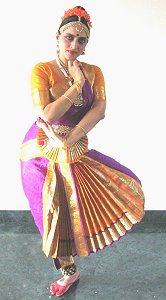
|
 |

|
 |
The art and science of Indian (Chola) bronzes - Sharada Srinivasan, Bangalore e-mail: sharasri@gmail.com January 28, 2007 (THE ART AND SCIENCE OF INDIAN (CHOLA) BRONZES, a lecture-cum-Bharatanatyam dance demonstration by Sharada Srinivasan on Feb 6, 2007 At Royal Asiatic Society, 14 Stephenson Way London NW1 2HD, UK)  Chola bronze icons from Tamil Nadu (c. 9th-13th century) in southern India, such as the Nataraja often described as cosmic dance of the Hindu god Siva, rank amongst the finest of religious expressions with often revelationary implications for our present day understanding of art, music, dance, poetry, science, history, society, psychology and philosophy, which this talk touches upon. While scholars of a scientific background, from Ananda Coomaraswamy to noted astronomer Carl Sagan, have perhaps been tempted to see 'cosmic' underpinnings to the Nataraja, art historians have been more cautious. However, archaeo-metallurgical and archaeo-astronomical studies in collaboration with Nirupama Raghavan for the first time suggest the possibility of a 'stellar' iconometric inspiration deriving from the constellation Orion and going back to the Pallava period (c. 800 AD). The idea that the 1054 AD supernova explosion impacted Chola bronzes and related rituals is also considered; suggesting an interesting synthesis of art and science in an era predating Leonardo da Vinci. It is suggested that the impulse to reconcile dualities exhibited by Chola iconography and the dual aspects of Nataraja worship at Chidambaram linking the cosmos and consciousness may also in part derive from Tamil poetic sensibilities as reflected in the interplay of 'inner' and 'outer' space of Tamil Sangam poetry (2nd c.BC-3rd c. AD) and the mystical poetry of Tamil saints such as Manikkavachakar (9th century). Highlights of Chola metal casting technology are touched upon as is the question of the enigmatic pancha-loha or five-metalled composition. The Nataraja icon can also be seen as something of a 'Jungian' archetype spurring the emergence of creativity from loss and destruction as a therapeutic process: especially in the light of the great accomplishments of the widowed 10th century Chola queen Sembiyan Mahadevi with dedications to her late husband Gandaraditya Chola, which also present a rare and fascinating example of the 'male muse' in the history of art. While the volume of Orientations, Vol. 37, No. 8, presents intriguing insights into how Chola bronzes represent beauty revealed and concealed by Vidya Dehejia and how they represented the activities of gods of seeing and being seen by John Guy, the author's talk also touches upon a third dimension whereby the bronze deities were also at times perhaps perceived quite literally and metaphorically as being 'Beyond Vision' (to borrow an astronomical book title by the late astronomer-musicologist, Jon Darius). The lecture will be animated by some Bharatanatyam dance sequences and abhinaya the expressive art of Bharatanatyam. The Orientations paper and the above talk also provides part of the material for an original script for a dance production in progress by Dr. Sharada Srinivasan entitled 'Beyond Vision, Beyond Life: Comprehending Siva's Cosmic Dance.' |